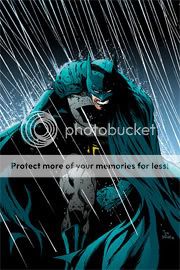Batman #664-669, 672-675
Grant Morrison, writer
Andy Kubert, J.H. Williams III, Tony Daniel, Ryan Benjamin, artists
DC Comics, April 2007-April 2008 or so
22 pages each
$2.99 each
Grant Morrison is my favorite superhero comics writer, one of the very few writers in comics I’ll read anything by. Batman is my favorite superhero, the only character I feel an attachment to as an entity rather than as a character in a story that may or may not be good by artists and writers who may or may not be good. Put Morrison and Batman together and you should have a recipe for Sean T. Collins Nirvana, but for some reason that hasn’t been the case. What I seem to recall being the standard Kubert Bros.-related scheduling difficulties early on; Morrison working in a deliberately choppy, almost disjointed narrative style both within individual issues and from issue to issue and short arc to short arc; sketchy, sloppy art from Kubert and unremarkable ’90s-style art from Daniel and Benjamin jarringly interrupted by a bona-fide star turn from the great J.H. Williams III; that awkwardly inserted Ra’s al-Ghul-centric crossover with all the other Bat-titles; my job at Wizard coming to an end and with it my weekly free access to superhero comics…put it all together and you have a book tailor-made for me that I wasn’t even following.
I was recently loaned a more or less complete run of Morrison’s tenure on the title–sans the initial “Batman & Son” arc that introduced Batman and Talia al-Ghul’s enfant terrible son Damian and the issues pertaining to the Ra’s al-Ghul crossover in which the old villain attempts rebirth in the body of his grandson–and I was pleased to discover I liked the whole thing a lot.
Like so many of Morrison’s long runs it’s badly hampered by the art he’s saddled with, perhaps moreso here than in other cases since so much of Morrison’s staccato scripting depends on nuances of body language, facial expression, and mise en scène. Meanwhile, that pow-pow-pow pacing and those brief, three- or two- or even one-issue story arcs give the illusion of a lack of continuity within the run overall. But taken in one sitting these problems are easily smoothed over, and what reveals itself is a dual project.
First, and credit here goes to my friend Kiel Phegley for pointing this out, Morrison foregrounding Batman as the main point of interest in every story. Whereas normally the character plays a particularly badass brand of straightman to the more glamorous villains and horrifying murder-mysteries he’s up against, Morrison’s emphasis is on the hero himself, and on establishing him as every bit as weird, exciting, scary, and memorable as his antagonists. This is reflected in Morrison’s choice of antagonists itself: as with All Star Superman, he’s trotting out a parade of baddies who in one way or another serve as his flawed doppelgangers. The peak-human-specimen al-Ghul family, the crimefighting Batmen of Many Nations and their billionaire benefactor, three crazed Batman-impersonating policemen, even Bat-Mite–they all throw what makes Batman Batman into sharper relief via contrast, demonstrating that while he is indeed weird, exciting, scary, and memorable, he’s also a fundamentally good person who never loses sight of the values that matter to him and by which he’s chosen to define himself.
Second, Morrison is slowly advancing a novel and vastly more enjoyable take on the shopworn “shadowy villain manipulating things behind the scenes” mega-storyline in the person of the Black Glove, a figure of unknown provenance behind many of the story’s events. Morrison has basically avoided those annoying scenes where the shadowy figure literally appears as a figure in shadows once or twice per issue, making ominous statements and showing us just enough of his silhouette that we can start guessing whether he’s Mysterio or Hush or whoever. Instead, Batman arranges his recent cases into a pattern at the center of which is a hole in the shape of something that’s more of an idea rather than a person–a “king of crime” figure so brilliantly evil that even Batman had no idea he existed and had been pulling strings for nearly Batman’s entirely career. It’s all coming out in this kind of slow, unnerving fashion, more identifiable as something feeling weird about the stories rather than as a story element in and of itself. Hopefully the central revelation will be as satisfying as that of, say, New X-Men. At any rate, while I can see why people (myself included) may have gotten a bit lost in the shuffle, I’m now reading some of the book’s more oblique storytelling choices as just that–choices–rather than lapses, and I’m firmly back on board.
Tags: comics, comics reviews, Comics Time, reviews

